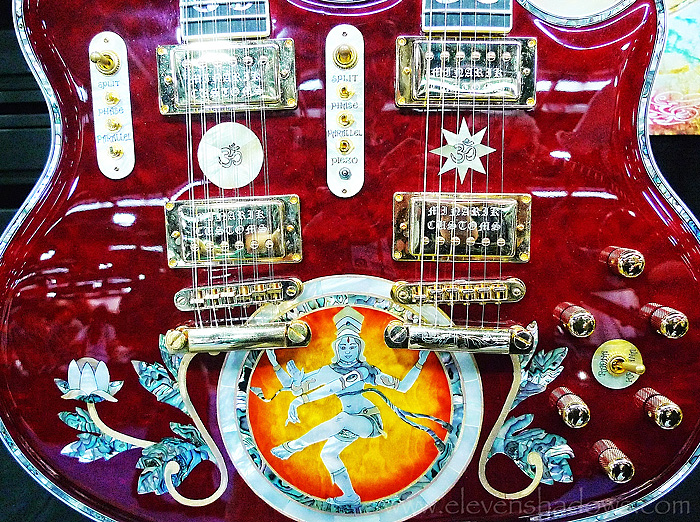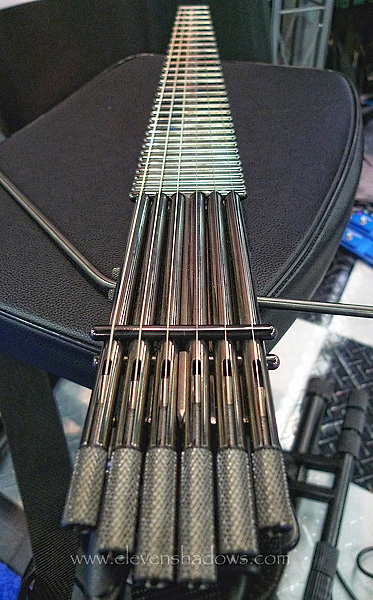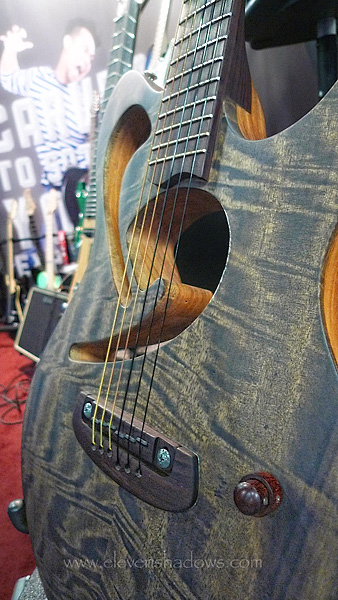
NAMMbulating 2013
NAMM Convention January 2013, Anaheim, CA
Page 1 of 3
Robotune: This is a robot made by www.goltar.com that tunes all six strings of your guitar simultaneously. It's portable and can tune most guitars (there's another version for guitars with tuning pegs on one side of the headstock). I think the guy might be on to something. And I know what you're going to ask: does it do alternate tunings? The answer is no, not yet. But I think there's going to be something in the works. |
To tune? You simply strum the guitar, and within seconds, the guitar is completely in tune. This could be really great for manufacturers, stores, music teachers, guitar techs, anybody who has to tune lots of guitars and get to work. And it might be good for someone who hates tuning, does it slowly, or whatever. Or in the recording studio, it would be good for accuracy because it tunes to within 1-2 cents AND tunes all strings simultaneously (for those who don't know, the act of tuning one string at a time can throw the tuning off the other strings slightly). The artist in me would love it if they could make the thing look fun, as right now, it looks utlitarian. I can't help but wonder if people would really love it if it looked like Darth Vader, a robot, kinda Geigeresque, steampunk, have an odd face on it, or something. |
 There was a buzz at NAMM about the new Moog Sub Phatty. I wasn't blown away by the Phatty, so I didn't have high hopes for a low end Phatty. But no, it was fun and quite flexible, also producing nice distortion. It doesn't just do low end, either. Moog says it has Multidrive to create gritty attack, assymetrical distortion, and saturated hard-clipping; sub-oscillator for window-shattering bass, a powerful noise generator, 100$ analog signal path, 2 new rock solid oscillators, classic Moog ladder filter, 16 on-board presets and panel mode, external audio input, and 25 semi-weighted keys with +/- 2 octave transposition. I just know that it was fun.
There was a buzz at NAMM about the new Moog Sub Phatty. I wasn't blown away by the Phatty, so I didn't have high hopes for a low end Phatty. But no, it was fun and quite flexible, also producing nice distortion. It doesn't just do low end, either. Moog says it has Multidrive to create gritty attack, assymetrical distortion, and saturated hard-clipping; sub-oscillator for window-shattering bass, a powerful noise generator, 100$ analog signal path, 2 new rock solid oscillators, classic Moog ladder filter, 16 on-board presets and panel mode, external audio input, and 25 semi-weighted keys with +/- 2 octave transposition. I just know that it was fun. |

What do Campbell's Soup and Rick Wakeman have in common? Both funded the Birotron in the mid to late '70s. The Birotron is a tape replay keyboard conceived by Dave Biro, and was a Mellotron-like instrument in the prototype stage that never quite made it to mass production. However, it was featured on a hit single and used on several albums and tours and received over 1000 advance orders from many prominent musicians worldwide including members of the Beatles and Led Zeppelin. It's now often considered the world's rarest keyboard instrument in the genres of pop/rock music. It also retains the highest selling price for any Mellotron related keyboard, and since its inception, has been one of the most difficult to find, seldom seen, and least recorded instruments in the entire world. Here it is, displayed in NAMM's "Treasures from the Attic" Display in Hall E. |
Designed and drafted by Don Lewis in 1974, LEO's unique ability to combine several synthesizers using one controller was a forerunner of things to come - namely the development of MIDI technology. The main components of LEO are the Hammond Concord Organ, two ARP 2600 synthesizers, 4 Oberheim Expander Modules, an ARP Pro-Soloist, a Pascetta keyboard, Roland Space Echo, Roland Promars, Roland Digital Chorus, and a Boss Mixer. Hall E is by far my favorite hall. It tends to have smaller companies, more innovation, more interesting and oddball stuff, and as a bonus, is a little quieter. Words cannot describe how overwhelming and loud the noise is on the NAMM floor. |
  Minarik guitars, located at the far end of Hall E. Any further and they'd be on Orangewood. They have beautiful workmanship, and always have interesting guitars. Minarik guitars, located at the far end of Hall E. Any further and they'd be on Orangewood. They have beautiful workmanship, and always have interesting guitars. |
 "Minimalism....at its Maximum", so the brochure of Gittler Instruments says. It features "a striking minimalist design incorporating rounded cylindrical and ergonomic features. The guitar is manufactured entirely of 6AL-4V aircraft grade titanium, and has been featured in the Museum of Modern Art in New York. "Minimalism....at its Maximum", so the brochure of Gittler Instruments says. It features "a striking minimalist design incorporating rounded cylindrical and ergonomic features. The guitar is manufactured entirely of 6AL-4V aircraft grade titanium, and has been featured in the Museum of Modern Art in New York. |
According to their brochure, the stylophone has become "possibly the best selling electronic keyboard instrument of all time, having sold over 4 million units globally in its 45 year life." The inventor created a keyboard that uses padsd on a printed circuit, and the player uses a metal-tipped stylus to create the electrical connection. This sort of keyboard could be manufactured cheaply. It's been used by David Bowie in 'Space Oddity", creating the glissando effect. This resulted in sales of the stylophone skyrocketing. It's also been used by Kraftwerk, Queen, Gotye, Orbital, and others. It has dual all-transistor VCOs, sub-oscillators for fat ol' bass, an auxiliary input (yippee!) so you can use it as an effects processor, eight-waveform LFO, and runs on four AA batteries. Wheeeeeeerrreeeeeeeeeee!!!!!!!!! |
 Stepballen Guitars makes some cool looking guitars, some made from mindiwood, lingua, mahagany, or other exotic woods. The guitar shown here is called the Neosynth, and although it can be played as any other electric guitar, it also sports a MIDI port. Furthermore, the guy said that they can make all sorts of custom guitars, pretty much anything, for approximately US$1300, which as you know, is extremely cheap for a custom guitar. Super nice people, too. Stepballen Guitars makes some cool looking guitars, some made from mindiwood, lingua, mahagany, or other exotic woods. The guitar shown here is called the Neosynth, and although it can be played as any other electric guitar, it also sports a MIDI port. Furthermore, the guy said that they can make all sorts of custom guitars, pretty much anything, for approximately US$1300, which as you know, is extremely cheap for a custom guitar. Super nice people, too. |
And now, let's let Korg describe this for you: An analog synthesizer featuring the original circuitry from 1978 Korg’s MS-20 monophonic synthesizer, first introduced in 1978, is still a coveted instrument to this day, thanks to its thick, robust sound, its powerful, iconic analog filter, and its versatile patching options. Highlights: 2VCO / 2VCA / 2VCF / 2EG / 1LFO structure Self-oscillating high-pass/low-pass filters with distinctive distortion External signal processor (ESP) Extremely flexible patching system Miniature MS-20 that's 86% of the original size MIDI IN and USB connector Replicates every detail of the original, down to the package binding and the included manual |
~~~ There seems to be three ways in which a booth can attract a huge crowd at NAMM: The latter attracted my friends and I to the Holophone booth. We stood in front for 45 minutes, helping them to drain their keg so it wouldn't be so hard wheeling it back out, and that was very sweet of us. Joining the group were Dave from VST in Pasadena (they can seemingly fix anything with a plug), Ana and her husband John (photographers and music freaks who have been coming to all four days of NAMM for 23 years), and songwriting extraordinaire Brian Blake. Chris tried to join us. He said he was at the Holophone booth. We were at the Holophone booth. Apparently, there were two, about 30 feet apart. I jumped up and down, and said, "Do you see me? I'm five feet in front of the booth, jumping around, waving my arms!" But no. So we continued to drink beer.
|
There, Joe Sample dropped by, said hi, and made a point to shake everyone's hand at the table (probably about 20 of us). Shown here is Eric and Tony with Joe. Joe Sample has had a successful solo career, and also played on albums by Miles Davis, George Benson, Jimmy Witherspoon, B. B. King, Eric Clapton, Steely Dan, The Supremes, Joni Mitchell, Marvin Gaye, Tina Turner, B. B. King, Joe Cocker, Minnie Riperton and Anita Baker. |
 Keyboard fanatics at the Keyboard Corner. Keyboard fanatics at the Keyboard Corner. |
 More Keyboard Corner folk hanging out at Buca di Beppo. More Keyboard Corner folk hanging out at Buca di Beppo. |
This year, for the first time, I got a cheap motel near the Anaheim Convention Center, so just before midnight, I drove over to the $45 room and promptly fell asleep. |
|
Ken's photos of Nobel Peace Prize Winner Aung
San Suu Kyi, as well as photos of Peru, Burma, India, Morocco, China, Thailand,
Ghana, Ecuador, and elsewhere, have appeared in many books, magazines,
websites, and galleries. Visit the
Ken Lee Photography Website. Some of Ken's select photos may be
purchased through his
Imagekind Store. |
NAMMbulating, January 2013
Page 1 of 3
Eleven Shadows Travel Page
Contact photographer/musician Ken Lee